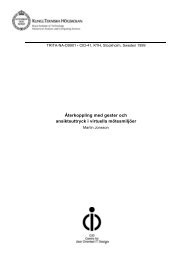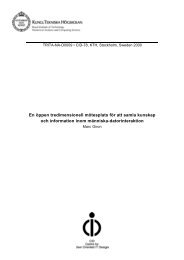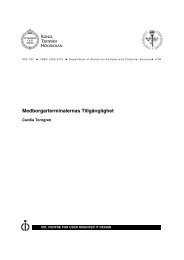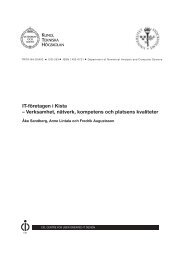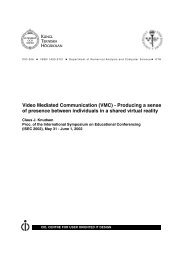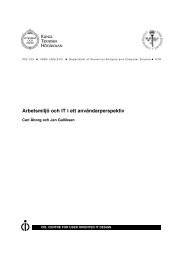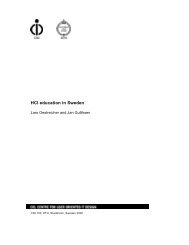New Institutionalism on the Internet - CID - KTH
New Institutionalism on the Internet - CID - KTH
New Institutionalism on the Internet - CID - KTH
Create successful ePaper yourself
Turn your PDF publications into a flip-book with our unique Google optimized e-Paper software.
Anders Hedman<str<strong>on</strong>g>New</str<strong>on</strong>g> <str<strong>on</strong>g>Instituti<strong>on</strong>alism</str<strong>on</strong>g> <strong>on</strong> <strong>the</strong> <strong>Internet</strong>Report number: TRITA-NA-D9812, <strong>CID</strong>-39ISSN number: ISSN 1403-073XPublicati<strong>on</strong> date: March 1999E-mail of author: ahedman@nada.kth.seReports can be ordered from:<strong>CID</strong>, Centre for User Oriented IT DesignNada, Dept. Computing Science<strong>KTH</strong>, Royal Institute of TechnologyS-100 44 Stockhom, Swedenteleph<strong>on</strong>e: + 46 8 790 91 00fax: + 46 8 790 90 99e-mail: cid@nada.kth.seURL: http://www.nada.kth.se/cid/
AbstractThe <strong>Internet</strong> has often been described as a new fr<strong>on</strong>tier housing endlesspossibilities within a democratic atmosphere. Informati<strong>on</strong> likes to be free—anexpressive phrase <strong>on</strong> <strong>the</strong> <strong>Internet</strong> reflecting a mentality of open criticalminds that were part of <strong>the</strong> nets genesis, but how free are organizati<strong>on</strong>s <strong>on</strong><strong>the</strong> <strong>Internet</strong>? Recent developments <strong>on</strong> <strong>the</strong> World Wide Web indicate that<strong>the</strong>re are structural forces at work greatly limiting <strong>the</strong> development of newweb sites. Although <strong>the</strong> medium is still in its infancy and many claim to besearching for guidelines in developing web sites, a closer look at currentweb sites and how <strong>the</strong>y are c<strong>on</strong>structed reveal str<strong>on</strong>g similarities in terms ofstructure and functi<strong>on</strong>ality. Web site development today is largely a matterof following unwritten laws that must be adhered to for purposes oflegitimizati<strong>on</strong>. This paper provides an explorative analysis of <strong>the</strong> currentsituati<strong>on</strong> and seeks possible explanati<strong>on</strong>s for <strong>the</strong> puzzling c<strong>on</strong>vergence ofweb sites.<strong>CID</strong>-39—<str<strong>on</strong>g>New</str<strong>on</strong>g> <str<strong>on</strong>g>Instituti<strong>on</strong>alism</str<strong>on</strong>g> <strong>on</strong> <strong>the</strong> <strong>Internet</strong> 3
<str<strong>on</strong>g>New</str<strong>on</strong>g> <str<strong>on</strong>g>Instituti<strong>on</strong>alism</str<strong>on</strong>g> <strong>on</strong> <strong>the</strong> <strong>Internet</strong>—Cognitive escapades in <strong>the</strong> age of networking…<strong>the</strong> essence of technology is by no means anythingtechnological. Thus we shall never experience our relati<strong>on</strong>shipto technology to <strong>the</strong> essence of technology so l<strong>on</strong>g as wemerely c<strong>on</strong>ceive and push forward <strong>the</strong> technological, put upwith it, or evade it. But we are delivered over to it in <strong>the</strong>worst possible way when we regard it as something neutral; forthis c<strong>on</strong>cepti<strong>on</strong> of it, to which today we particularly like todo homage, makes us utterly blind to <strong>the</strong> essence oftechnology. (Heidegger, 1977 p4)The <strong>Internet</strong> and organizati<strong>on</strong>sIn <strong>the</strong> early days industry did not pay much attenti<strong>on</strong> to <strong>the</strong> media, buttoday <strong>the</strong> World Wide Web and <strong>the</strong> <strong>Internet</strong>-technologies have attained astate of importance unrivalled by any o<strong>the</strong>r kinds of computer technologies.The <strong>Internet</strong>-technologies can be said to fuel <strong>the</strong> computer industry, and<strong>the</strong>y have become part of a new ubiquitous infrastructure for <strong>the</strong>development of modern business models (Laud<strong>on</strong> 98). The majority of newapplicati<strong>on</strong>s are developed with <strong>the</strong> <strong>Internet</strong> in mind, and <strong>the</strong> <strong>Internet</strong>technologiesserve as a comm<strong>on</strong> platform that is becoming increasinglyenmeshed with <strong>the</strong> workings of everyday business life. Technology andbusiness life as part of our social reality are things inseparable for <strong>the</strong>ydetermine each o<strong>the</strong>r (Hedman 96, MacKenzie 85). To understand <strong>the</strong>development of <strong>the</strong> <strong>Internet</strong> and <strong>the</strong> business drives enabling its rapidgrowth warrants integrative approaches to technology and organizati<strong>on</strong>s(Davenport 92, Davenport 97). Laud<strong>on</strong> and o<strong>the</strong>rs argue that we shouldview <strong>the</strong>m as sociotechnical systems (Laud<strong>on</strong> 98).<strong>CID</strong>-39—<str<strong>on</strong>g>New</str<strong>on</strong>g> <str<strong>on</strong>g>Instituti<strong>on</strong>alism</str<strong>on</strong>g> <strong>on</strong> <strong>the</strong> <strong>Internet</strong> 4
The web as nexusWhat ties all <strong>the</strong> <strong>Internet</strong>-technologies toge<strong>the</strong>r is largely <strong>the</strong> web. It is easyto see why. The Web is simple to use, and traditi<strong>on</strong>al IS-applicati<strong>on</strong>s can beintegrated with it. Through such integrati<strong>on</strong> <strong>the</strong> user can access an evergrowing number of different services with little effort. The need to learnhow to use specialized <strong>Internet</strong>-applicati<strong>on</strong>s and technologies diminishes as<strong>the</strong> integrati<strong>on</strong> process unfolds and today users can deploy <strong>the</strong> web toperform almost any network oriented task.Web sites as extra featuresWhen <strong>the</strong> first web sites were developed in commercialized settings <strong>the</strong>ywere often regarded as extra features. A company would, for example, putup a web site which served a similar purpose as a leaflet. Those who visited<strong>the</strong> web site could learn about <strong>the</strong> company by browsing through web pagesthat marketed <strong>the</strong> company in ways similar to printed materials. A typicalweb site would for example house <strong>the</strong> following informati<strong>on</strong>:•= Product informati<strong>on</strong>•= Goals and visi<strong>on</strong>s•= C<strong>on</strong>tact informati<strong>on</strong>The experience of using such sites was often similar to reading an ordinaryleaflet, and many complaints were raised that such use was unimaginative,and n<strong>on</strong>-productive.Web sites as dreams of interactivityVisi<strong>on</strong>aries preached about using <strong>the</strong> web as an interactive medium—usersshould be able to interact with web sites in more novel ways <strong>the</strong>y said. Aweb site, according to this early interacti<strong>on</strong>ist approach, should not simplybe something that users read, it should be a place were users are much moreactive. While such thoughts were popular, few managed to develop siteswhich were truly interactive or even knew what <strong>the</strong> word meant. In part thishad to do with <strong>the</strong> state of <strong>the</strong> technology. In <strong>the</strong> early days before Java,and o<strong>the</strong>r interactivity-enabling technologies, developing interactive siteswas difficult. But, <strong>the</strong>re were also o<strong>the</strong>r reas<strong>on</strong>s for why such developmentsdid not take place more than <strong>the</strong>y did. In many cases <strong>the</strong> medium wassimply not thought of as anything more than ano<strong>the</strong>r feature. The situati<strong>on</strong>is changing rapidly. However—interactivity <strong>the</strong> magic word—has lost itsspell-casting powers.<strong>CID</strong>-39 — <str<strong>on</strong>g>New</str<strong>on</strong>g> <str<strong>on</strong>g>Instituti<strong>on</strong>alism</str<strong>on</strong>g> <strong>on</strong> <strong>the</strong> <strong>Internet</strong> 5
Web sites as enmeshed in <strong>the</strong> organizati<strong>on</strong>al structureThe web as medium has g<strong>on</strong>e from a situati<strong>on</strong> of being used much as anextra feature to something much more critical to modern organizati<strong>on</strong>s.Interactivity is no l<strong>on</strong>ger such a big deal. People regularly use <strong>the</strong> web as anextended versi<strong>on</strong> of <strong>the</strong> Yellow pages, look up bus schedules or get o<strong>the</strong>rkinds of simple facts.Not <strong>on</strong>ly has <strong>the</strong> World Wide Web become more intimately tied toorganizati<strong>on</strong>s, but this has happened to <strong>Internet</strong>-technologies in general.The best examples are perhaps recent developments of intranets withinorganizati<strong>on</strong>s and extranets between <strong>the</strong>m. Although <strong>the</strong> very c<strong>on</strong>cept of anintranet is not easily defined, and many rivaling c<strong>on</strong>ceptualizati<strong>on</strong>s exist,intranets are based <strong>on</strong> a set of standardized <strong>Internet</strong>-technologies.Companies with intranets have started to rely <strong>on</strong> such sets of <strong>Internet</strong>technologiesfor <strong>the</strong>ir informati<strong>on</strong>-technology infrastructure. The Web hasmade its way from <strong>the</strong> <strong>Internet</strong> and is now making up for an ever-increasingnumber of organizati<strong>on</strong>al infrastructures. Web-technologies are simply partof <strong>the</strong> nexus of informati<strong>on</strong> technology within intranets or those out <strong>on</strong> <strong>the</strong><strong>Internet</strong>. Intranets and extranets were c<strong>on</strong>structed out of business c<strong>on</strong>cernsand we can observe a shift towards a use of <strong>the</strong> medium as becoming morecentral to organizati<strong>on</strong>al activities. Whe<strong>the</strong>r we examine intra-organizati<strong>on</strong>alcommunicati<strong>on</strong>, sales of products, customer support, or o<strong>the</strong>r comm<strong>on</strong>organizati<strong>on</strong>al activities, <strong>the</strong> web has for many companies become part of<strong>the</strong> clockwork.Well developed web sites enhance <strong>the</strong> organizati<strong>on</strong>s behind <strong>the</strong>m,because <strong>the</strong>y not <strong>on</strong>ly reflect <strong>the</strong> structures of those organizati<strong>on</strong>s, but <strong>the</strong>yare inseparable from those very same structures. The web-medium does not workin parallel with organizati<strong>on</strong>s, it becomes enmeshed with <strong>the</strong>m. When a companydecides to build a web site that company has to reflect <strong>on</strong> a variety of issuessuch as:•=•=•=•=•=Organizati<strong>on</strong>al structureImageCustomersMarket opportunitiesGoals & visi<strong>on</strong>sSuch reflecti<strong>on</strong>s are <strong>the</strong>n materialized <strong>on</strong> <strong>the</strong> web in a c<strong>on</strong>crete form. A website is a tangible representati<strong>on</strong> of something that o<strong>the</strong>rwise might be seenas a very complex abstract phenomena, but <strong>on</strong> <strong>the</strong> web you can (at least in6<strong>CID</strong>-39 — <str<strong>on</strong>g>New</str<strong>on</strong>g> <str<strong>on</strong>g>Instituti<strong>on</strong>alism</str<strong>on</strong>g> <strong>on</strong> <strong>the</strong> <strong>Internet</strong>
some sense) browse this abstract entity. It is <strong>the</strong>re and it is tangible, even ifnot fully accurate. A web site, however, also gives a more accuratedescripti<strong>on</strong>s of an organizati<strong>on</strong> than a leaflet or a videotape because it is (orshould in general be):•= Updated frequently•= Rich with informati<strong>on</strong>•= Factual and less wordy than printed mediaMany web sites also go bey<strong>on</strong>d informati<strong>on</strong> and allow customers to interactdirectly with <strong>the</strong> organizati<strong>on</strong> behind <strong>the</strong> web site. From <strong>the</strong> point of viewof <strong>the</strong> user, he or she is interacting directly with <strong>the</strong> company. The web canbe said to change organizati<strong>on</strong>s in at least two important ways: structurallyand discursively.Structural changesStructural changes are brought about when <strong>the</strong> web and relatedtechnologies become part of an organizati<strong>on</strong>s technological infrastructure.An intranet can, for example change this infrastructure most markedly byallowing for:•= Discussi<strong>on</strong> forums•= Electr<strong>on</strong>ic calendars•= Homepages•= Shared work areasNothing is perhaps new or novel in <strong>the</strong>se technologies per se. Still, wheninformati<strong>on</strong> technologies are implemented and taken seriously, <strong>the</strong>y not<strong>on</strong>ly allow for new ways of interacting within organizati<strong>on</strong>s, <strong>the</strong>y alsochange or replace traditi<strong>on</strong>al ways of working. The structural impacts can bec<strong>on</strong>siderable.Discursive changesDiscursive changes stem from discussi<strong>on</strong>s about <strong>the</strong> use of <strong>the</strong> web and itsrelated technologies. The company that decides to build a web site is likelyto go through many issues regarding how to present <strong>the</strong> organizati<strong>on</strong> <strong>on</strong> <strong>the</strong>web. These discussi<strong>on</strong>s are likely to change <strong>the</strong> overall c<strong>on</strong>cepti<strong>on</strong> of <strong>the</strong>organizati<strong>on</strong>. In many cases an organizati<strong>on</strong>s web site can become a centraldiscussi<strong>on</strong> piece. It is a c<strong>on</strong>crete representati<strong>on</strong> of an organizati<strong>on</strong> which canserve to help newly hired to orient <strong>the</strong>mselves within <strong>the</strong> organizati<strong>on</strong>, but<strong>CID</strong>-39 — <str<strong>on</strong>g>New</str<strong>on</strong>g> <str<strong>on</strong>g>Instituti<strong>on</strong>alism</str<strong>on</strong>g> <strong>on</strong> <strong>the</strong> <strong>Internet</strong> 7
it can also be a starting point for deeper analyses of an organizati<strong>on</strong> ingeneral.Technology and organizati<strong>on</strong>al changeNo <strong>on</strong>e doubts that computer technology has become an important part ofmodern organizati<strong>on</strong>s. Few are <strong>the</strong> companies that could survive more thana few days without <strong>the</strong>ir local area network, and work usually means usingcomputers in <strong>on</strong>e way or ano<strong>the</strong>r. Today as organizati<strong>on</strong>s embrace <strong>the</strong><strong>Internet</strong>-technologies in general and <strong>the</strong> web in particular, <strong>the</strong> technologyhas become of more central c<strong>on</strong>cern than at any earlier point in time.Organizati<strong>on</strong>s have, during <strong>the</strong> last two years, been rushing to <strong>the</strong> <strong>Internet</strong>in search for new markets and better ways of using technology.One way of analyzing this rushing towards <strong>the</strong> net would be to think of<strong>the</strong> companies as rati<strong>on</strong>al agents composed of rati<strong>on</strong>al decisi<strong>on</strong>-makersal<strong>on</strong>g <strong>the</strong> lines of rati<strong>on</strong>al choice <strong>the</strong>ory (Elster, 89). Pars<strong>on</strong>s <strong>on</strong>cedominated sociological organizati<strong>on</strong>al research in <strong>the</strong> US with a <strong>the</strong>orydependant <strong>on</strong> a variant of rati<strong>on</strong>al choice <strong>the</strong>ory (Craib, 92). In <strong>the</strong> viewoffered by rati<strong>on</strong>al choice <strong>the</strong>ory-variants, companies seek out new ways ofdoing business because <strong>the</strong>y sense market opportunities and/or ways ofattaining better technological infrastructures. Such a view tends to neglectseveral c<strong>on</strong>textual issues.<str<strong>on</strong>g>New</str<strong>on</strong>g> instituti<strong>on</strong>alismAccording to <strong>the</strong> traditi<strong>on</strong> of new instituti<strong>on</strong>alism within <strong>the</strong> field oforganizati<strong>on</strong>al analysis, instituti<strong>on</strong>al change is best understood fromanalyzing factors that go bey<strong>on</strong>d individual organizati<strong>on</strong>s (DiMaggio 91).Individual organizati<strong>on</strong>s are seen as shaped from without ra<strong>the</strong>r than fromwithin. External envir<strong>on</strong>ments lay at <strong>the</strong> basis of instituti<strong>on</strong>al changes anddevelopments. As <strong>the</strong> envir<strong>on</strong>ment acts <strong>on</strong> <strong>the</strong> organizati<strong>on</strong>, <strong>the</strong>organizati<strong>on</strong> comes to adopt new classificati<strong>on</strong>s, routines and schemas. In asubtle way <strong>the</strong> envir<strong>on</strong>ment comes to create fundamental frameworks ofcogniti<strong>on</strong> within organizati<strong>on</strong>s:Envir<strong>on</strong>ments…are more subtle in <strong>the</strong>ir influence; ra<strong>the</strong>r thanbeing co-opted by organizati<strong>on</strong>s, <strong>the</strong>y penetrate <strong>the</strong>organizati<strong>on</strong>, creating <strong>the</strong> lenses through which actors view8<strong>CID</strong>-39 — <str<strong>on</strong>g>New</str<strong>on</strong>g> <str<strong>on</strong>g>Instituti<strong>on</strong>alism</str<strong>on</strong>g> <strong>on</strong> <strong>the</strong> <strong>Internet</strong>
<strong>the</strong> world and <strong>the</strong> very categories of structure, acti<strong>on</strong>, andthought. (DiMaggio 91, p 13)It is <strong>the</strong> inherent limits of cogniti<strong>on</strong> that leads to passive acceptance ofpressures from <strong>the</strong> external envir<strong>on</strong>ment. On such a view rati<strong>on</strong>al decisi<strong>on</strong>making is no where to be found within organizati<strong>on</strong>s. Todays fast pacedworld leaves organizati<strong>on</strong>s with no choice, but to accept prefabricatedformal frameworks <strong>on</strong> this view.Technological requirementsThe new instituti<strong>on</strong>alism of <strong>the</strong> web is partly technologically driven. Havinga web site is taken as a natural requirement in modern business life.Organizati<strong>on</strong>s without web sites run <strong>the</strong> risk of being labeled astechnologically obsolete. No <strong>on</strong>e doubts that <strong>the</strong> deployment of technologycan give companies market advantages. Companies that fail to deploycutting edge technology can often be perceived as less aggressive and lesssuccessful. The underlying technological demand does not come fromwithin, but from without. The demand surfaces because <strong>the</strong>re aretechnological norms dictating how companies should use technology.Customers today have come to expect that “<strong>the</strong>ir” companies are <strong>on</strong> <strong>the</strong>web and that <strong>the</strong>y can interact with <strong>the</strong>m. Similarly business to businessrelati<strong>on</strong>s have come to become dependent <strong>on</strong> extranet technologies.Moreover, many expect companies to have <strong>the</strong>ir own intranets.Organizati<strong>on</strong>s who cannot participate in <strong>the</strong> extranet business might losepotential business partners. Thus <strong>the</strong>re are many external forces at work indetermining <strong>the</strong> course of organizati<strong>on</strong>al deployment of <strong>the</strong> <strong>Internet</strong> and itsrelated technologies.C<strong>on</strong>ceptual requirementsThe deployment of <strong>the</strong> <strong>Internet</strong>-related technologies, and especially <strong>the</strong> webis a subject that has brought much attenti<strong>on</strong> from o<strong>the</strong>r media, as well asfrom <strong>the</strong> <strong>Internet</strong>-community. There are countless sites that publish styleguides and <strong>the</strong>y almost invariably claim to know how to develop web sitesfruitfully. Although <strong>the</strong> medium is still quite young it already has itsgenerally acknowledged gurus, as well as many self proclaimed <strong>on</strong>es.<strong>CID</strong>-39 — <str<strong>on</strong>g>New</str<strong>on</strong>g> <str<strong>on</strong>g>Instituti<strong>on</strong>alism</str<strong>on</strong>g> <strong>on</strong> <strong>the</strong> <strong>Internet</strong> 9
The law of <strong>the</strong> webWhile <strong>the</strong> <strong>Internet</strong> has been described as a free, open-ended medium withlimitless possibilities, <strong>the</strong>re are also str<strong>on</strong>g c<strong>on</strong>straining forces at work. Asbusiness organizati<strong>on</strong>s and o<strong>the</strong>r instituti<strong>on</strong>s make <strong>the</strong>ir way <strong>on</strong>to <strong>the</strong> net<strong>the</strong>y are driven by desires to be successful in what <strong>the</strong>y do and <strong>the</strong>y try tofind sound advice <strong>on</strong> how to best utilize <strong>the</strong> technology. In resp<strong>on</strong>se to this,<strong>the</strong> web has rapidly become associated with standard ways of developingweb sites and deploying <strong>Internet</strong>-related technologies. Companies alsospend much time spying <strong>on</strong> each o<strong>the</strong>r through <strong>the</strong> web. A spokesmanfrom Ericss<strong>on</strong> (Infomaster 98) stated that <strong>the</strong>y had a lot of traffic coming into <strong>the</strong>ir site from a small town in <strong>the</strong> U.S. They w<strong>on</strong>dered why this smalltown had such an interest in <strong>the</strong>ir site until some<strong>on</strong>e pointed out thatMotorola, a competitor, had <strong>the</strong>ir central office <strong>the</strong>re.Style guidesStyle guides have been found <strong>on</strong> <strong>the</strong> web since its incepti<strong>on</strong>. They aremeant to aid in <strong>the</strong> web-development process by giving advice <strong>on</strong> what todo and <strong>on</strong> what to avoid. There are at least thousands of such general styleguides <strong>on</strong> <strong>the</strong> net. Am<strong>on</strong>gst <strong>the</strong> more authoritative are:•= Yale Style Guide 1•= Sun Style Guide 2•= W3C Style Guide 3It is comm<strong>on</strong> practice, and a courtesy for those who develop <strong>the</strong>ir own styleguides to link to such authorative guides. It is not so strange <strong>the</strong>refore that<strong>the</strong> advices given are repeated over and over again and again.Desperati<strong>on</strong>Jacob Nielsen, <strong>the</strong> world-leading expert <strong>on</strong> web site usability claims at hisown web site that “… <strong>the</strong> Web is desperate for design rules…” 4 . There is adanger in such desperati<strong>on</strong>, and that is that organizati<strong>on</strong>s building web sites maylose track of <strong>the</strong> real issues. The questi<strong>on</strong> is how well design—an insightfulcreative phenomena—can exist in a world of desperati<strong>on</strong> and hype aboutnew technologies. When companies lose <strong>the</strong>mselves in desperati<strong>on</strong>, <strong>the</strong>yend up holding <strong>on</strong> to ready-made rules. These may not lead to very creativeor unique designs; <strong>the</strong>y could become organizati<strong>on</strong>al straight jackets.10<strong>CID</strong>-39 — <str<strong>on</strong>g>New</str<strong>on</strong>g> <str<strong>on</strong>g>Instituti<strong>on</strong>alism</str<strong>on</strong>g> <strong>on</strong> <strong>the</strong> <strong>Internet</strong>
AbsolutismAt TechWeb, a large-scale site providing informati<strong>on</strong> about <strong>Internet</strong>-relatedtechnologies <strong>the</strong>y claim that “There is a definite science behind Web sitedesign…” 5 . This propositi<strong>on</strong> at first might seem perfectly natural, but whyshould we think that <strong>the</strong>re is a science behind design? Doesn’t designinvolve artistry, and estethics? It is not at all clear that design ever could bereduced to science, no matter what kind of design we are discussing. Thepropositi<strong>on</strong> reveals an attitude towards design <strong>on</strong> <strong>the</strong> web as being amechanical process, determinate and scientific. It reduces design to <strong>the</strong>following of rules. The design of web sites becomes a manner of followingnorms. Such positivistic norms weave <strong>the</strong> fabric of straightjackets.GroupthinkIt is a well known psychological fact that groups with charismatic leadersand/or closed internal belief systems tend to overestimate <strong>the</strong>ir own graspof problems <strong>the</strong>y encounter (Janis 82). The traditi<strong>on</strong> of web sitedevelopment lacks nei<strong>the</strong>r of <strong>the</strong>se features.FormalityThe larger a group becomes, <strong>the</strong> more formal it tends to become. The webdevelopment community is certainly a sizeable group and <strong>the</strong> number ofstyle guides, as well as <strong>the</strong>ir striking c<strong>on</strong>vergence, can be seen as an attemptto bring focus to it. The web community searches for tangible rules that willbring order and c<strong>on</strong>creteness.DogmaOne could argue whe<strong>the</strong>r or not <strong>the</strong> Web is, as Nielsen claims, in desperateneed of design rules, but at any rate many are willing to produce whatappears to be such rules:This article will break down <strong>the</strong> essential characteristicsof great Web sites into some easily followed rules ofthumb. 6Modern web sites, and o<strong>the</strong>r <strong>Internet</strong> applicati<strong>on</strong>s are more than some extrafeature of an organizati<strong>on</strong>. They are enmeshed with organizati<strong>on</strong>s, andcannot be separated from <strong>the</strong>m. To understand what a great web site isshould require more than just following easy rules of thumb. A brief look atsome of <strong>the</strong> book titles from <strong>the</strong> <strong>on</strong>line business litterature gives <strong>on</strong>e a verydifferent impressi<strong>on</strong>:<strong>CID</strong>-39 — <str<strong>on</strong>g>New</str<strong>on</strong>g> <str<strong>on</strong>g>Instituti<strong>on</strong>alism</str<strong>on</strong>g> <strong>on</strong> <strong>the</strong> <strong>Internet</strong> 11
•= Cyberlaw; What You Need to Know about Doing Business Online (Johnst<strong>on</strong> 97)•=Web<strong>on</strong>omics; The Nine Essential Principles for Growing Your Business <strong>on</strong> <strong>the</strong>World Wide Web (Schwartz 98)•= Online Marketing Handbook (Janal 98)Business books in general are notorious for making str<strong>on</strong>g optimisic claimsregarding simple effective rules and principles, but <strong>the</strong> <strong>on</strong>line businessliterature appears to take this approach to a higher level so to speak:Everything you need to know to harness <strong>the</strong> full power of <strong>the</strong><strong>Internet</strong> for your promoti<strong>on</strong>al, advertising, and sellingendeavors is here. (Whiley & S<strong>on</strong>s about <strong>the</strong>ir OnlineMarketing Handbook - Janal 98)This statement, as well as <strong>the</strong> title of <strong>the</strong> book, reveals an attitude that“business <strong>on</strong> <strong>the</strong> <strong>Internet</strong>” is simply a matter of following c<strong>on</strong>crete advicefrom a single volyme. Whiley & S<strong>on</strong>s is a respected publisher and <strong>the</strong>y arenot al<strong>on</strong>e in taking <strong>on</strong> this attidude. In fact, most publishers within <strong>the</strong>genre appear to be of <strong>the</strong> same basic opini<strong>on</strong>. The web is <strong>the</strong>re to c<strong>on</strong>querfor business organizati<strong>on</strong>s that learn <strong>the</strong> rules of <strong>the</strong> game. But such aperspective is false from <strong>the</strong> beginning. This is why: business life, nor sociallife can be separated from technological developments. Modern society issocio-technological in nature and <strong>the</strong>refore <strong>the</strong> decopuling from businessand technology is impossible. The litterature that focuses <strong>on</strong> <strong>the</strong> businessorganizati<strong>on</strong>, <strong>on</strong> <strong>the</strong> <strong>on</strong>e hand, and its deployment of technology <strong>on</strong> <strong>the</strong>o<strong>the</strong>r is deeply misguiding. Part of understanding a business era (any <strong>on</strong>ethroughout history) is understanding how it is enmeshed with technologywhatever <strong>the</strong> technological artefacts may be. In our era, as so<strong>on</strong> as abusiness enters <strong>on</strong>line it is transformed, it changes because its technologychanges. Is <strong>the</strong> fear of such changes what makes organizati<strong>on</strong>s cling sostr<strong>on</strong>gly to simple recipies and SOP:s? For <strong>the</strong> truth of <strong>the</strong> matter is thatfew of todays business organizati<strong>on</strong>s are likely to be around in <strong>the</strong> nextdecade or so 1 . Those who will be around are those who can understandsomething much more crucial than recepies—our business era. Laud<strong>on</strong> &Laud<strong>on</strong> are two of <strong>the</strong> few writers who take seriously <strong>the</strong> challenge of how1 For example, of <strong>the</strong> Fortune 500 companies in 1918 less than ten percentsurvived for 50 years. (Laud<strong>on</strong> 89).12<strong>CID</strong>-39 — <str<strong>on</strong>g>New</str<strong>on</strong>g> <str<strong>on</strong>g>Instituti<strong>on</strong>alism</str<strong>on</strong>g> <strong>on</strong> <strong>the</strong> <strong>Internet</strong>
to understand a business era as being partly c<strong>on</strong>stituted by and enmeshedwith technology (Laud<strong>on</strong> & Laud<strong>on</strong> 98).AtmosphereApart from <strong>the</strong> fact that <strong>the</strong>re are sources out <strong>on</strong> <strong>the</strong> web that c<strong>on</strong>tribute toa new kind of instituti<strong>on</strong>alism by attempting to define all wide scope normsthat govern and mechanize web site design, <strong>the</strong>re is also as Nielsen claims adesperati<strong>on</strong> for help and advice. Many organizati<strong>on</strong>s are new to <strong>the</strong> weband <strong>the</strong>y have very little understanding of <strong>the</strong> media. In such a setting, it is<strong>on</strong>ly natural that <strong>the</strong>y are struggling to find out how to better deploy it. Toanswer <strong>the</strong>ir needs web c<strong>on</strong>sultancy firms have emerged quickly. Still <strong>the</strong>sefirms have often not existed for more than a year or so, and thus <strong>the</strong>y are<strong>the</strong>mselves new to <strong>the</strong> medium. In a sense every<strong>on</strong>e is hungry forknowledge. The safest bet is likely to be this: follow <strong>the</strong> herd.LegitimacyLegitimacy has become an important factor in designing web sites. Whenc<strong>on</strong>sultants are hired to help with web site development <strong>the</strong>ir ways ofestablishing credibility is often based <strong>on</strong> norms of web site design found <strong>on</strong><strong>the</strong> net. They can also refer to earlier producti<strong>on</strong>s of successful web sites asa way of establishing credibility, which naturally also leads to fur<strong>the</strong>rhomogenizati<strong>on</strong>. The end result may be that a particular c<strong>on</strong>sultancy agencyproduces many sites that appear very similar. The organizati<strong>on</strong>s that acquireweb sites are tacitly accepting this, because by indirectly accepting externallylegitimated formal structures (Meyer 91) <strong>the</strong>y increase <strong>the</strong> commitment of<strong>the</strong>ir members, business partners and customers.The associative effectInformati<strong>on</strong> is w<strong>on</strong>derfully accessible <strong>on</strong> <strong>the</strong> <strong>Internet</strong>. For those part of website-projects this means that <strong>the</strong>y can easily study o<strong>the</strong>r sites, check withusability guidelines and get informati<strong>on</strong> <strong>on</strong> web site design from variouso<strong>the</strong>r sources. At a time when many are seeking advice <strong>on</strong> web site designthis accessibility may well come to serve a homogenizing functi<strong>on</strong>.Successful sites can easily be imitated and even copied. What appears in <strong>on</strong>estyle guide can be equally easily incorporated into ano<strong>the</strong>r. In a time ofdesperate knowledge seeking, copying and imitating is safe. The net is in asense a huge associative network, much like a mind map. The net is a<strong>CID</strong>-39 — <str<strong>on</strong>g>New</str<strong>on</strong>g> <str<strong>on</strong>g>Instituti<strong>on</strong>alism</str<strong>on</strong>g> <strong>on</strong> <strong>the</strong> <strong>Internet</strong> 13
ainstorming phenomena. Every organizati<strong>on</strong> with a web site has a node in<strong>the</strong> mind map, and <strong>the</strong>y pay close attenti<strong>on</strong> to o<strong>the</strong>r nodes. Surely such aprocess must lead to many new and novel ideas? Surely this must be an eraof discovery and insight? There are two factors that work against creativityand discovery <strong>on</strong> <strong>the</strong> web. One is <strong>the</strong> kind of new instituti<strong>on</strong>alism that isinfluencing web site development, <strong>the</strong> o<strong>the</strong>r is what can be termed <strong>the</strong>associative effect. Within <strong>the</strong> field of social psychology studies have shownthat large groups that engage in brainstorming activities, in general producefewer novel ideas than when each participating pers<strong>on</strong> brainstorm byherself (Lamm 73). Groups that brainstorm have a tendency to pick up <strong>on</strong>certain ideas as dominant and o<strong>the</strong>rs are never expressed . The web works<strong>the</strong> same way, <strong>the</strong>re are certain ideas that are very prominent <strong>on</strong> <strong>the</strong> webregarding web-development and <strong>the</strong>y have a tendency to structure <strong>the</strong> weband <strong>the</strong> very thoughts we have about web-development. These ideas arepresent <strong>on</strong> <strong>the</strong> web and <strong>the</strong>y are easily accessible, much like in a giantbrainstorming sessi<strong>on</strong>. C<strong>on</strong>formity to <strong>the</strong>se ideas is comm<strong>on</strong>, and thus werisk ending up with dominating cognitive frameworks that structure thoughtabout organizati<strong>on</strong>al web-development.Possible homogenizing factorsFrom <strong>the</strong> analysis so far <strong>on</strong>e could hypo<strong>the</strong>size that <strong>the</strong> following factorsmay be c<strong>on</strong>tributing to an evoluti<strong>on</strong> towards more similar types of websites.FormalityNeed foradviceOpeness andaccessibilityHomogenizingfactorsGroupthinkLegitimizingprocessAssociativityFigure 1 Homogenizing factors <strong>on</strong> <strong>the</strong> World Wide WebFrom <strong>the</strong> perspective presented here, <strong>the</strong> web is a collaborative project. Theweb is created by large agents that all have <strong>the</strong> possibility of observing <strong>the</strong>14<strong>CID</strong>-39 — <str<strong>on</strong>g>New</str<strong>on</strong>g> <str<strong>on</strong>g>Instituti<strong>on</strong>alism</str<strong>on</strong>g> <strong>on</strong> <strong>the</strong> <strong>Internet</strong>
developments. As in all such large groups were developments are openlydisplayed <strong>the</strong> phenomen<strong>on</strong> of homogeneity raises its head.Fundamental cognitive determinantsNo <strong>on</strong>e doubts that <strong>the</strong> web and <strong>the</strong> <strong>Internet</strong> is a media-space partly based<strong>on</strong> hype and sometimes simple prepackaged soluti<strong>on</strong>s for organizati<strong>on</strong>s thatwant to utilize <strong>the</strong> medium, but what is it that lies at <strong>the</strong> bottom of <strong>the</strong>development of organizati<strong>on</strong>s <strong>on</strong> <strong>the</strong> web?NetworkingOne of <strong>the</strong> most powerful ideas of this age is <strong>the</strong> idea of networking. It isnot possible to understand how organizati<strong>on</strong>s work today withoutunderstanding <strong>the</strong> c<strong>on</strong>cept of networking. It is such a dominant <strong>the</strong>me inmost, if not all organizati<strong>on</strong>s today. It is in a sense more than a simplec<strong>on</strong>cept, it is a whole philosophy. This philosophy lies behind <strong>the</strong> <strong>Internet</strong>and it is part of <strong>the</strong> essence of <strong>the</strong> <strong>Internet</strong>. It also points <strong>the</strong> way towardsunderstanding organizati<strong>on</strong>s from <strong>the</strong> new instituti<strong>on</strong>al perspective.Because, as I will try to make clear, it is a cognitive phenomena that lies wellbey<strong>on</strong>d individual organizati<strong>on</strong>s, yet it governs organizati<strong>on</strong>s and determine<strong>the</strong>ir structures and <strong>the</strong>ir inner workings.C<strong>on</strong>nectivityPart of <strong>the</strong> philosophy of networking is c<strong>on</strong>nectivity. C<strong>on</strong>nectivity has to dowith <strong>the</strong> ways in which various devices can be c<strong>on</strong>nected to a network andhow easy such a process is. The trend is clearly towards greater and greaterc<strong>on</strong>nectivity. When <strong>the</strong> new addressing scheme for <strong>the</strong> <strong>Internet</strong> (IPV6) wasworked out <strong>on</strong>e choose to make it a 128 bit addressing scheme. To <strong>the</strong> laypers<strong>on</strong> that may not mean much. If you work out <strong>the</strong> possiblecombinati<strong>on</strong>s with 128 bits you get roughly 1,70 * 10^38. This addressingscheme is built for unc<strong>on</strong>strained c<strong>on</strong>nectivity. In <strong>the</strong> future we might wellimagine that just about anything with a processor and TCP/IP (<strong>the</strong> <strong>Internet</strong>protocols) can be hooked up to <strong>the</strong> <strong>Internet</strong>—everything from refrigeratorsto supercomputers.<strong>CID</strong>-39 — <str<strong>on</strong>g>New</str<strong>on</strong>g> <str<strong>on</strong>g>Instituti<strong>on</strong>alism</str<strong>on</strong>g> <strong>on</strong> <strong>the</strong> <strong>Internet</strong> 15
Technology as a means of revealingThe classical view of technology is as means to ends. Technology is seen asinstrumental in this view. Although such a view of technology surely iscorrect. It is according to Heidegger still not true to <strong>the</strong> essence oftechnology:The correct always fixes up<strong>on</strong> something pertinent inwhatever is under c<strong>on</strong>siderati<strong>on</strong>. However, in order to becorrect, this fixing by no means needs to uncover <strong>the</strong> thingin questi<strong>on</strong> in its essence. (Heidegger, p6 1977)If we take Heidegger seriously, we can not understand technology withoutunderstanding <strong>the</strong> forces that drive technology. On such a view, what wecomm<strong>on</strong>ly think of as technology are merely manifestati<strong>on</strong>s of underlyingdeterminants.Technology and cogniti<strong>on</strong>According to some advocates of new instituti<strong>on</strong>alism, <strong>the</strong> workings oforganizati<strong>on</strong>s can be explained in terms of cognitive supra-organizati<strong>on</strong>alaspects. This radical approach emphasizes <strong>the</strong> external envir<strong>on</strong>ment inwhich organizati<strong>on</strong>s have <strong>the</strong>ir lives. Organizati<strong>on</strong>s are <strong>on</strong> such a view notaut<strong>on</strong>omous, and are ultimately completely resistant to intenti<strong>on</strong>al analysis.The determinants of acti<strong>on</strong> and decisi<strong>on</strong> making come from outside <strong>the</strong>organizati<strong>on</strong>s and forces <strong>the</strong> organizati<strong>on</strong>s to act in ways which are bey<strong>on</strong>d<strong>the</strong>ir c<strong>on</strong>trol–<strong>the</strong> organizati<strong>on</strong>s are merely puppets in <strong>the</strong> hands of <strong>the</strong>master envir<strong>on</strong>ment.ORGANIZATIONALFIELDNORMSRULESOrganisatoi<strong>on</strong>Organisatoi<strong>on</strong>Organisatoi<strong>on</strong>Organisatoi<strong>on</strong>Organisatoi<strong>on</strong>Organisatoi<strong>on</strong>Organisatoi<strong>on</strong>Organisatoi<strong>on</strong>Organisatoi<strong>on</strong>Organisatoi<strong>on</strong>Organisatoi<strong>on</strong>Organisatoi<strong>on</strong>Organisatoi<strong>on</strong>Organisatoi<strong>on</strong>Figure 2 supra-cognitive new instituti<strong>on</strong>alismWe might call this variant of new instituti<strong>on</strong>alism supra-cognitive newinstiuti<strong>on</strong>alism (from here <strong>on</strong> referred to as SCNI). But were exactly is thatsupra-cognitive realm and how does it work?16<strong>CID</strong>-39 — <str<strong>on</strong>g>New</str<strong>on</strong>g> <str<strong>on</strong>g>Instituti<strong>on</strong>alism</str<strong>on</strong>g> <strong>on</strong> <strong>the</strong> <strong>Internet</strong>
The idea appears to be that <strong>the</strong> supra-cognitive realm is made up ofnorms and rules which float above <strong>the</strong> organizati<strong>on</strong>s in a Hegelian-likeuniversal mind. The organizati<strong>on</strong>s are <strong>the</strong>n in some more or less mysteriousways shaped by <strong>the</strong>se rules. The power of transforming and sustainingorganizati<strong>on</strong>s lies in <strong>the</strong> rules of <strong>the</strong> supra-cognitive realm. According to <strong>the</strong>SCNI-perspective <strong>the</strong> organizati<strong>on</strong>s <strong>the</strong>mselves are nei<strong>the</strong>r free nor are <strong>the</strong>yrati<strong>on</strong>al. Whe<strong>the</strong>r or not organizati<strong>on</strong>s are rati<strong>on</strong>al, irrati<strong>on</strong>al, free or not, isan issue open for debate, but that <strong>the</strong>ir members follow unc<strong>on</strong>scious rulesseems odd. They may well have developed dispositi<strong>on</strong>s to act in certainways and not o<strong>the</strong>rs, but that is not <strong>the</strong> same thing as followingunc<strong>on</strong>scious rules.We can acknowledge <strong>the</strong> extremely complex, rule-governedstructures of human instituti<strong>on</strong>s, and we can alsoacknowledge that those rule-governed structures play acausal role in <strong>the</strong> structure of our behavior, but I want topropose that in many cases it is just wr<strong>on</strong>g to assume…thatour behavior matches <strong>the</strong> structure of <strong>the</strong> rules because weare unc<strong>on</strong>sciously following rules. Ra<strong>the</strong>r we evolve a set ofdispositi<strong>on</strong>s that are sensitive to <strong>the</strong> rule structure.(Searle, 95, p 95)We humans engage in a variety of activities in our everyday life, and manyof <strong>the</strong>m can perhaps be characterized as being in line with systems of rules,but that does not mean that we are attempting to follow any rules or that<strong>the</strong>y are somehow part of our mentality. Searle expresses this point quiteclearly:Let me give you a thought experiment that will illustrate<strong>the</strong> line of explanati<strong>on</strong> I am proposing. Suppose <strong>the</strong>re were atribe where children just grew up playing baseball. Theynever learn <strong>the</strong> rules as codified rules but are rewarded orcriticized for doing <strong>the</strong> right thing or <strong>the</strong> wr<strong>on</strong>g thing. Forexample, if <strong>the</strong> child has three strikes, and he says “Can’tI have ano<strong>the</strong>r chance?” he is told, “No, now you have to sitdown and let some<strong>on</strong>e else come up to bat.” We can supposethat <strong>the</strong> children just become very skillful at playingbaseball. Now also suppose that a foreign anthropologisttries to describe <strong>the</strong> culture of <strong>the</strong> tribe. A goodanthropologist might come up with <strong>the</strong> rules of baseball justby describing <strong>the</strong> behavior of <strong>the</strong>se people and what <strong>the</strong>yregard as normative in baseball situati<strong>on</strong>s. But it does notfollow from <strong>the</strong> accuracy of <strong>the</strong> anthropological descripti<strong>on</strong>that <strong>the</strong> members of this society are c<strong>on</strong>sciously orunc<strong>on</strong>sciously following those rules. N<strong>on</strong>e<strong>the</strong>less, thoserules do play a crucial rule in <strong>the</strong> explanati<strong>on</strong> of <strong>the</strong>irbehavior, because <strong>the</strong>y have acquired <strong>the</strong> dispositi<strong>on</strong>s that<strong>the</strong>y have, precisely because those are <strong>the</strong> rules ofbaseball. (Searle, 1995, p 144-145)<strong>CID</strong>-39 — <str<strong>on</strong>g>New</str<strong>on</strong>g> <str<strong>on</strong>g>Instituti<strong>on</strong>alism</str<strong>on</strong>g> <strong>on</strong> <strong>the</strong> <strong>Internet</strong> 17
Much of social reality is indeed rule governed, but in order for us to engagein those rule governed parts, we need not be acting up<strong>on</strong> mental rules. It isunclear that paying for coffee at a café before leaving need to involve anymental rule following, whe<strong>the</strong>r c<strong>on</strong>scious or not. Similarly, people standcloser to eacho<strong>the</strong>r when <strong>the</strong>y c<strong>on</strong>verse in Latin America than in Sweden,but that certainly does not imply that people in Sweden and Latin Americafollow different mental rules, <strong>the</strong>y just go about standing <strong>the</strong> way <strong>the</strong>y dobecause <strong>the</strong>y are accustomed to.Finding a safe home for informati<strong>on</strong> and cognitiveprocessesWhy should we think of human complying with norms as manifestingc<strong>on</strong>scious or unc<strong>on</strong>scious rules? It is indeed a very comm<strong>on</strong> perspectivethat to some extent stems from <strong>the</strong> field of artificial intelligence with <strong>the</strong>work of researchers such as Herbert Sim<strong>on</strong>, and Allan <str<strong>on</strong>g>New</str<strong>on</strong>g>ell (Sim<strong>on</strong> 1969,<str<strong>on</strong>g>New</str<strong>on</strong>g>ell 72). From a psychological perspective, cognitive psychology with itsemphasis <strong>on</strong> variati<strong>on</strong>s <strong>on</strong> <strong>the</strong> computer model (Anders<strong>on</strong> 90, p10) andstrands of thinking from <strong>the</strong> artificial intelligence heritage became <strong>the</strong>dominating model after behaviorism started to lose its attracti<strong>on</strong>. Cognitivepsychology, and cognitive science is still a well respected way of makinginquires into our mental workings. Much of those inquiries are undertakenwith <strong>the</strong> computer model as starting point. In <strong>the</strong> standard introductory textto <strong>the</strong> field of human computer interacti<strong>on</strong> (Dix et al, 93 p10) <strong>the</strong> view of<strong>the</strong> user is based <strong>on</strong> a computer model. The user is seen as a rule drivensystem which processes informati<strong>on</strong> in calculative manners according torules.Cognitive escapadesDuring <strong>the</strong> era of behaviorism, <strong>the</strong> workings of mental capacities werescientifically not a legitimate area of inquiry. The cognitive revoluti<strong>on</strong>(Gardner 85) changed that and <strong>the</strong> focus was turned from <strong>the</strong> envir<strong>on</strong>mentand its effect <strong>on</strong> behavior to <strong>the</strong> individual and her inner mental capacities.CognitivismTo some extent this move to cogniti<strong>on</strong> was made legitimate in <strong>the</strong> eyes ofmany by natural and simple computer model. The field of artificialintelligence had its glory days in <strong>the</strong> late sixties until <strong>the</strong> mid-eighties when it18<strong>CID</strong>-39 — <str<strong>on</strong>g>New</str<strong>on</strong>g> <str<strong>on</strong>g>Instituti<strong>on</strong>alism</str<strong>on</strong>g> <strong>on</strong> <strong>the</strong> <strong>Internet</strong>
still had failed to deliver many of its early promises (Dreyfus 92). Cognitivescience relied <strong>on</strong> <strong>the</strong> same machines as sources of inspirati<strong>on</strong> and to someextent evidence for that <strong>the</strong> computati<strong>on</strong>al informati<strong>on</strong>-processing modelwas correct. Since <strong>the</strong> incepti<strong>on</strong> of cognitive psychology <strong>the</strong> view ofcogniti<strong>on</strong> has become diversified however, according to some of <strong>the</strong>seviews cogniti<strong>on</strong> cannot be understood as something harbored <strong>on</strong>ly within<strong>the</strong> brain or a single system. Situated acti<strong>on</strong> <strong>the</strong>ory, distributed cogniti<strong>on</strong>and activity <strong>the</strong>ory are all examples of <strong>the</strong>ories which emphasize alternativeways of exploring cogniti<strong>on</strong> in terms of c<strong>on</strong>textual dependence, interrelatedsystems and <strong>the</strong> role of ordinary day-to-day acti<strong>on</strong>s.Rati<strong>on</strong>alistic models and situated acti<strong>on</strong>Situated acti<strong>on</strong> models (Suchman 1987) can be seen as a resp<strong>on</strong>se to <strong>the</strong>rati<strong>on</strong>alistic models of human cogniti<strong>on</strong> and general coping in differentenvir<strong>on</strong>ments. According to <strong>the</strong> standard model of cognitive science,humans can be characterized as goal driven informati<strong>on</strong>-processing agents.On this cognitive model , an attempt is made to explain human behavior interms of calculati<strong>on</strong>s <strong>on</strong> internal representati<strong>on</strong>s derived from inputmechanisms. Those operati<strong>on</strong>s are in turn guided by internal goals andplans. In short, human activity <strong>on</strong> <strong>the</strong> standard cognitive model is anactivity dependent <strong>on</strong> internal representati<strong>on</strong>s, input and output units(senses), memory and informati<strong>on</strong> processing or more precisely calculati<strong>on</strong>s.On this model humans act because <strong>the</strong>y are trying to fulfill a goal or a plan–<strong>the</strong>ir acti<strong>on</strong>s are goal driven, purposive and rati<strong>on</strong>alistic.Situated acti<strong>on</strong> can be seen as a resp<strong>on</strong>se to this rati<strong>on</strong>alistic model. Therati<strong>on</strong>alistic model stems largely from <strong>the</strong>oretical models in computerscience, and in particular from <strong>the</strong> field of artificial intelligence (Boden 88,Haugeland 81, 85, Johns<strong>on</strong>-Laird 88).Many experimental computer programs from <strong>the</strong> early era of <strong>the</strong> AI fieldwere modeled <strong>on</strong> rati<strong>on</strong>alistic goal oriented models, and as artificialintelligence later became at least partly absorbed into cognitive psychologyand cognitive science in general, <strong>the</strong> models were also migrated. Artificialintelligence programs have always had difficulty in coping with complexenvir<strong>on</strong>ments and novel situati<strong>on</strong>s. In a similar vein cognitive models ofhumans coping in complex envir<strong>on</strong>ments are difficult to c<strong>on</strong>struct. It issimply difficult to model and explain such behavior in terms of entities suchas rules, memory, representati<strong>on</strong>s and calculati<strong>on</strong>s. The whole cognitiveapparatus derived from rati<strong>on</strong>alistic AI models appear embarrassinglysimplistic.<strong>CID</strong>-39 — <str<strong>on</strong>g>New</str<strong>on</strong>g> <str<strong>on</strong>g>Instituti<strong>on</strong>alism</str<strong>on</strong>g> <strong>on</strong> <strong>the</strong> <strong>Internet</strong> 19
On <strong>the</strong> situated acti<strong>on</strong> model humans are able to cope with complexenvir<strong>on</strong>ments because <strong>the</strong>y are able to improvise (Lave 1988) in novelsituati<strong>on</strong>s no matter how unique <strong>the</strong>y are. Moreover <strong>the</strong>y do so withoutfollowing rules, strategies or plans. On this model such things arerati<strong>on</strong>alistic c<strong>on</strong>structi<strong>on</strong>s generated after <strong>the</strong> coping has taken place.Solving any kind of work task is, <strong>on</strong> <strong>the</strong> str<strong>on</strong>gest versi<strong>on</strong> of situated acti<strong>on</strong>,always a matter of interacting with <strong>the</strong> envir<strong>on</strong>ment; work is carried out insitu <strong>on</strong>ly by interacting with <strong>the</strong> envir<strong>on</strong>ment.The model of situated acti<strong>on</strong> has a behavioristic after-taste. Theenvir<strong>on</strong>ment in some sense governs <strong>the</strong> human. Goals, plans and strategieshave no or little importance, because such things are seen as explanatoryc<strong>on</strong>structi<strong>on</strong>s that have little or no bearing <strong>on</strong> how a particular task iscarried out. Thus what goes <strong>on</strong> in <strong>the</strong> head of <strong>the</strong> individual is not of centralinterest. In order to understand how a pers<strong>on</strong> interacts with anenvir<strong>on</strong>ment, <strong>the</strong> preferred way is to make detailed observati<strong>on</strong>s of <strong>the</strong>users, but how <strong>the</strong>y characterize or perceive <strong>the</strong> situati<strong>on</strong> is not of anygreater significance. The understanding lies in paying attenti<strong>on</strong> to <strong>the</strong>complexity of <strong>the</strong> envir<strong>on</strong>ment, which often is d<strong>on</strong>e by watching videos ofhuman activities. Situated acti<strong>on</strong> models express a general c<strong>on</strong>cern toexplain human behavior without referring to mental processes.Distributed cogniti<strong>on</strong>This view of cogniti<strong>on</strong> is basically in line with <strong>the</strong> traditi<strong>on</strong>al assumpti<strong>on</strong>s ofcognitive science that humans and computers can be treated in similar waysas far as cogniti<strong>on</strong> goes. Accordingly, <strong>the</strong> prop<strong>on</strong>ents of distributedcogniti<strong>on</strong> do not view cogniti<strong>on</strong> per se differently, but <strong>the</strong>y enlarge <strong>the</strong>scope of cognitive analysis. Cogniti<strong>on</strong> is not analyzed in localized singularentities such as humans or computers, but as phenomena occurring indistributed systems (Flor & Hutchins 1991). This means that humans,computers and all sorts of o<strong>the</strong>r physical artifacts are seen as part of acognitive system. For example, a number of humans working toge<strong>the</strong>r usingnetworked computers would be cognitive sub-systems of <strong>the</strong> wholecognitive system made up of networked computers, possible o<strong>the</strong>r artifactsand humans.According to <strong>the</strong> view of distributed cogniti<strong>on</strong>, humans, computers, aswell as o<strong>the</strong>r artifacts stand <strong>on</strong> equal footing in that <strong>the</strong>y can be thought ofas making up cognitive systems. Distributed cogniti<strong>on</strong> aims for moreexplanatory power by enlarging <strong>the</strong> scope of cognitive analysis, but <strong>the</strong>20<strong>CID</strong>-39 — <str<strong>on</strong>g>New</str<strong>on</strong>g> <str<strong>on</strong>g>Instituti<strong>on</strong>alism</str<strong>on</strong>g> <strong>on</strong> <strong>the</strong> <strong>Internet</strong>
traditi<strong>on</strong>al fundamental assumpti<strong>on</strong>s of cognitive science lie untouched at<strong>the</strong> core of <strong>the</strong> perspective.Activity <strong>the</strong>oryWhile distributed cogniti<strong>on</strong> can be seen as an elaborati<strong>on</strong> <strong>on</strong> <strong>the</strong> traditi<strong>on</strong>alcognitive science model, activity <strong>the</strong>ory (Nardi 1996) takes a different path.Activity <strong>the</strong>ory also stands in c<strong>on</strong>trast to <strong>the</strong> situated acti<strong>on</strong> model. Both <strong>the</strong>model of situated acti<strong>on</strong> and distributed cogniti<strong>on</strong> treat humans as more orless mechanically functi<strong>on</strong>ing entities. In <strong>the</strong> view of distributed cogniti<strong>on</strong>,humans are cognitive systems just like any o<strong>the</strong>r kind of such system suchas computers or o<strong>the</strong>r artifacts. According to <strong>the</strong> situated acti<strong>on</strong>perspectives, acti<strong>on</strong> is more or less completely c<strong>on</strong>text dependent.Intenti<strong>on</strong>alistic entities such as plans and goals are taken as rati<strong>on</strong>alizati<strong>on</strong>safter <strong>the</strong> fact; humans are reactive mechanical entities resp<strong>on</strong>ding tofeatures of <strong>the</strong> envir<strong>on</strong>ment.In activity <strong>the</strong>ory nei<strong>the</strong>r cogniti<strong>on</strong> nor <strong>the</strong> envir<strong>on</strong>ment are explanatoryelements, but <strong>the</strong> unit of analysis is activity. Activity <strong>the</strong>ory provides for ananalysis embracing intenti<strong>on</strong>ality, human subjectivity and adaptability.Le<strong>on</strong>t’ev (1974) describes activity as composed of subject, object, acti<strong>on</strong>s,and operati<strong>on</strong>s. The subject holds <strong>on</strong>e or several objects, which can bethought of as objectives in that <strong>the</strong>y guide <strong>the</strong> subject. The subject’s acti<strong>on</strong>sstem from <strong>the</strong>se objects which guides <strong>the</strong> subject. Objects can in turn beseen as arising from desires. In acting <strong>the</strong> subject attempts to reach <strong>the</strong> goalof meeting her objects through c<strong>on</strong>scious purposive intenti<strong>on</strong>al acti<strong>on</strong>, but<strong>the</strong> objectives are not seen as set in st<strong>on</strong>e–<strong>the</strong>y can change dynamically–dueto <strong>the</strong> envir<strong>on</strong>ment or o<strong>the</strong>r actors.Although <strong>the</strong> subject is seen as acting c<strong>on</strong>sciously <strong>on</strong> <strong>the</strong> level of goaldirected behavior, <strong>the</strong> ways in which acti<strong>on</strong>s are carried out need not in<strong>the</strong>mselves be c<strong>on</strong>scious. Acti<strong>on</strong>s are carried out through operati<strong>on</strong>s, and<strong>the</strong> more frequently operati<strong>on</strong>s are carried out, <strong>the</strong> less c<strong>on</strong>scious <strong>the</strong>y maybecome. Still, subjects hold <strong>the</strong> objects of acti<strong>on</strong> c<strong>on</strong>sciously andpurposively in mind. Objects shape activity, and what distinguishes <strong>on</strong>eactivity from ano<strong>the</strong>r is a questi<strong>on</strong> of knowing what objects come into play.<str<strong>on</strong>g>New</str<strong>on</strong>g> instituti<strong>on</strong>alismWhy should we think of organizati<strong>on</strong>s as intenti<strong>on</strong>al agents? One answer isthat our standard organizati<strong>on</strong>al vocabulary suggests that <strong>the</strong>y are suchagents. When, for example, <strong>the</strong> DOJ calls Microsoft to court, <strong>the</strong>vocabulary and <strong>the</strong> language used suggest that Microsoft is a c<strong>on</strong>sciously<strong>CID</strong>-39 — <str<strong>on</strong>g>New</str<strong>on</strong>g> <str<strong>on</strong>g>Instituti<strong>on</strong>alism</str<strong>on</strong>g> <strong>on</strong> <strong>the</strong> <strong>Internet</strong> 21
goal driven agent. The company is accused of having applied unfairmarketing tactics. The company might get into trouble and so <strong>on</strong>. Thewhole idea of bringing an organizati<strong>on</strong> to court is that it in some way can beheld accountable as an intenti<strong>on</strong>al agent. On closer inspecti<strong>on</strong> our use oflanguage indicates that this is how we c<strong>on</strong>ceptualize organizati<strong>on</strong>s. Wemight say things such that a company exploits its customer, is near sighted,pollutes <strong>the</strong> envir<strong>on</strong>ment, cares about its customers and so forth. But hardlydo we speak of <strong>the</strong>m as not being intenti<strong>on</strong>al.At <strong>the</strong> heart of new instituti<strong>on</strong>alism (DiMaggio 1991), lie questi<strong>on</strong>sregarding <strong>the</strong> more traditi<strong>on</strong>al intenti<strong>on</strong>alistic variants of organizati<strong>on</strong>al<strong>the</strong>ory. We also find a latent critique of rati<strong>on</strong>alism. Organizati<strong>on</strong>s are nol<strong>on</strong>ger seen as rati<strong>on</strong>al agents acting purposefully and veraciously towardscarefully chosen goals. Nor are <strong>the</strong> employees seen as acting al<strong>on</strong>g <strong>the</strong> linesof such rati<strong>on</strong>alism. In fact, nei<strong>the</strong>r organizati<strong>on</strong>s nor individuals are viewedas free cognitive agents. Organizati<strong>on</strong>s and <strong>the</strong>ir members are seen as partof a larger schema, a schema <strong>the</strong> workings of which is to be found <strong>on</strong> asupraorganizati<strong>on</strong>al level.The supraorganizati<strong>on</strong>al level is composed of interacti<strong>on</strong>s am<strong>on</strong>g sets oforganizati<strong>on</strong>s within fields (market sectors). The supraorganizati<strong>on</strong>al level isnot a phenomen<strong>on</strong> devoid of culture and value. It harbors many taken forgranted facts, schemas, rules and regulati<strong>on</strong>s that perhaps can be seen asmaking up a picture of <strong>the</strong> world or a part of <strong>the</strong> world. Such a pictureencompasses <strong>the</strong> cognitive ground for discussi<strong>on</strong>, judgement and workwithin and between organizati<strong>on</strong>s.<str<strong>on</strong>g>New</str<strong>on</strong>g> instituti<strong>on</strong>alism is essentially a cognitive model. According to it,cogniti<strong>on</strong> within organizati<strong>on</strong>s can be understood in terms of cognitiveframeworks emerging from organizati<strong>on</strong>al fields. Organizati<strong>on</strong>s may talkabout creativity, restructuring and inventing new ways of working, butaccording to new instituti<strong>on</strong>alism such activities are always to be foundwithin <strong>the</strong> cognitive straightjackets of organizati<strong>on</strong>al fields. There is noescape. The cognitive frameworks of new instituti<strong>on</strong>alism: rules, guidelines,schemas, procedures, beliefs and o<strong>the</strong>r artifacts of thought thatorganizati<strong>on</strong>s are bound to follow, are not necessarily c<strong>on</strong>sciously createdby intenti<strong>on</strong>al agents, but should ra<strong>the</strong>r be seen as emergent phenomenac<strong>on</strong>stitutive as well as dependent <strong>on</strong> organizati<strong>on</strong>al fields.22<strong>CID</strong>-39 — <str<strong>on</strong>g>New</str<strong>on</strong>g> <str<strong>on</strong>g>Instituti<strong>on</strong>alism</str<strong>on</strong>g> <strong>on</strong> <strong>the</strong> <strong>Internet</strong>
Social technology – <strong>the</strong> technologicalmaterializati<strong>on</strong> of new instituti<strong>on</strong>alismOn <strong>the</strong> standard model of new instituti<strong>on</strong>alism organizati<strong>on</strong>al behavior andstructure can be accounted for in terms of cognitive elements harbored inorganizati<strong>on</strong>al fields, as well as in society at large. The model of explanati<strong>on</strong>is a cognitive model attempting to make clear how thought and acti<strong>on</strong> inrelati<strong>on</strong> to modern organizati<strong>on</strong>s are shaped by formal as well as less formalrules, guidelines schemas and o<strong>the</strong>r normative mental determinants ofbehavior. The underlying assumpti<strong>on</strong> appears to be that organizati<strong>on</strong>s sharecognitive frameworks that could perhaps also be characterized as subworlds.Each such sub-world is, in Wittgenstenian terminology, associatedwith its own world picture of reality. It seems to me that this is really whatnew instituti<strong>on</strong>alism holds as its cognitive fundament. Wittgenstein writeseloquently about world pictures and how <strong>the</strong>y work as cognitivedeterminants:94. …I did not get my picture of <strong>the</strong> world by satisfyingmyself of its correctness; nor do I have it because I amsatisfied of its correctness. No; it is <strong>the</strong> inheritedbackground against which I distinguish between true andfalse.95. The propositi<strong>on</strong>s describing this world-picture might bepart of a kind of mythology. And <strong>the</strong>ir role is like that ofrules of a game and <strong>the</strong> game can be learned purelypractically, without learning any explicit rules.(Wittgenstein, 1969 p15e)Wittgenstein’s work On Certainty (1969) is epistemological in nature. Hismain c<strong>on</strong>cern is knowledge and certainty. It gives us an interestingbackdrop against which new instituti<strong>on</strong>alism can be analyzed and betterunderstood. He proposes that arguments should not be analyzed in anatomic way <strong>on</strong>ly in terms of singular rules, facts or schemas, but that <strong>the</strong>yrequire a more inclusive perspective:105. All testing, all c<strong>on</strong>firmati<strong>on</strong> and disc<strong>on</strong>firmati<strong>on</strong> of ahypo<strong>the</strong>sis takes place already within a system. And thissystem is not a more or less arbitrary and doubtful point ofdeparture for all our arguments: no, it bel<strong>on</strong>gs to <strong>the</strong>essence of what we call an argument. The system is not somuch <strong>the</strong> point of departure, as <strong>the</strong> element in whicharguments have <strong>the</strong>ir life. (Wittgenstein, 1969 p17e)Wittgenstein forces us to think about systems of thought, and <strong>the</strong> nature ofarguments. Arguments <strong>on</strong>ly have <strong>the</strong>ir life in systems. But, <strong>the</strong> systems<strong>CID</strong>-39 — <str<strong>on</strong>g>New</str<strong>on</strong>g> <str<strong>on</strong>g>Instituti<strong>on</strong>alism</str<strong>on</strong>g> <strong>on</strong> <strong>the</strong> <strong>Internet</strong> 23
<strong>the</strong>mselves are not part of <strong>the</strong> arguments, we do not step out of ourargumentative structures and watch <strong>the</strong>m from above as it were.Wittgenstein’s statements about arguments find res<strong>on</strong>ance in newinstituti<strong>on</strong>alism. Workers, administrators and CEOs may argue as much as<strong>the</strong>y please and <strong>the</strong>y may think that such arguments stem from someveracious rati<strong>on</strong>ality, but in Wittgenstein’s view any argument is boundwithin <strong>the</strong> c<strong>on</strong>fines of a system.What we find governing organizati<strong>on</strong>s, <strong>on</strong> our elaborated view of newinstituti<strong>on</strong>alism, are systems of thought that arise in sub-universes ourorganizati<strong>on</strong>al fields. But, where are those systems of thought? How can<strong>the</strong>ir <strong>on</strong>tology to be characterized? Wittgenstein gives a simple, but perhapsdisturbing answer:204. Giving grounds…justifying <strong>the</strong> evidence, comes to anend;–but <strong>the</strong> end is not certain propositi<strong>on</strong>s’ striking usimmediately as true, i.e. it is not a kind of seeing <strong>on</strong> ourpart; it is our acting… (Wittgenstein, 1969 p28e)Could it be <strong>the</strong> case that what lies at bottom of organizati<strong>on</strong>al fields areungrounded ways of acting? This would be disturbing for mostorganizati<strong>on</strong>s. Claiming legitimacy in terms of ways of acting does notsound rati<strong>on</strong>al, nor scientific. Still, if we reject old instituti<strong>on</strong>alism in favorof new instituti<strong>on</strong>alism we are in a sense leaving behind rati<strong>on</strong>alism, and weno l<strong>on</strong>ger regard organizati<strong>on</strong>al behavior as grounded in rati<strong>on</strong>ality. Rati<strong>on</strong>alor not, it is humans that create instituti<strong>on</strong>s. We create <strong>the</strong>m although ourrelati<strong>on</strong> to <strong>the</strong>m may become that of estrangement.I do not wish to settle <strong>the</strong> questi<strong>on</strong>s of instituti<strong>on</strong>al <strong>on</strong>tology, but merelypoint out an alternative to comm<strong>on</strong> <strong>on</strong>tologies. We might agree withWittgenstein <strong>on</strong> that at bottom of all thought lies acting, or we may havemore traditi<strong>on</strong>al cognitive views of thought and acti<strong>on</strong>. These issues arecertainly food for thought, but let us leave <strong>the</strong>m for a while. Let us take astep back in our analysis. We have covered a lot of ground in <strong>the</strong>se fewpages here. We have discussed new instituti<strong>on</strong>alism as opposed to oldinstituti<strong>on</strong>alism, and al<strong>on</strong>g <strong>the</strong> way we encountered situated cogniti<strong>on</strong>,distributed cogniti<strong>on</strong> and activity <strong>the</strong>ory as well as Wittgenstein’sepistemology. What divides <strong>the</strong> strands of thinking in <strong>the</strong>se different areas isthought itself.Each of <strong>the</strong> perspectives have, fundamentally different views <strong>on</strong> thinkingor more scientifically sounding, <strong>the</strong>y have different views of cogniti<strong>on</strong>.Activity <strong>the</strong>ory, situated cogniti<strong>on</strong> and Wittgenstein epistemology bel<strong>on</strong>gtoge<strong>the</strong>r <strong>on</strong> <strong>the</strong> <strong>on</strong>e hand, and so do old instituti<strong>on</strong>alism, newinstituti<strong>on</strong>alism and distributed cogniti<strong>on</strong> <strong>on</strong> <strong>the</strong> o<strong>the</strong>r hand. Prop<strong>on</strong>ents of24<strong>CID</strong>-39 — <str<strong>on</strong>g>New</str<strong>on</strong>g> <str<strong>on</strong>g>Instituti<strong>on</strong>alism</str<strong>on</strong>g> <strong>on</strong> <strong>the</strong> <strong>Internet</strong>
<strong>the</strong> latter group attempt to find models of cogniti<strong>on</strong> that are locati<strong>on</strong>focused. Let us call this group locati<strong>on</strong>al cognitivists. With locati<strong>on</strong> focusedI do not merely mean to say that this group is interested in localizingcogniti<strong>on</strong> per se. I am not trying to make <strong>the</strong> point that <strong>the</strong>y are out <strong>on</strong>some epistemological hunting activity. I am proposing that <strong>the</strong>ir treatmentof human coping cannot be decoupled from a str<strong>on</strong>g stand <strong>on</strong> cognitivelocati<strong>on</strong>. For <strong>the</strong> old instituti<strong>on</strong>alist, organizati<strong>on</strong>s and <strong>the</strong>ir members actdependent <strong>on</strong> cogniti<strong>on</strong> performed by individuals in <strong>the</strong> organizati<strong>on</strong>, andperhaps also by <strong>the</strong> organizati<strong>on</strong> as a whole–<strong>the</strong> organizati<strong>on</strong> as a cognitiveagent. In <strong>the</strong> perspective of distributed cogniti<strong>on</strong> thought occurs throughdistributed systems. One takes a step out of <strong>the</strong> traditi<strong>on</strong>al cognitive model<strong>on</strong> which cognitive processes are localized to a single individual. Cogniti<strong>on</strong>is instead modeled as having multiple systems making up a cognitivesubstrate. These systems can be artifacts or humans. Thus distributedsystems is <strong>the</strong> realm of cogniti<strong>on</strong>, not organizati<strong>on</strong>s, not humans, notmachines, but cognitive systems. <str<strong>on</strong>g>New</str<strong>on</strong>g> instituti<strong>on</strong>alism has a radicallydifferent view of cogniti<strong>on</strong>. Here we localize <strong>the</strong> cognitive realm as existingsupraorganizati<strong>on</strong>ally. The realm of cogniti<strong>on</strong> appears to become somethinglike <strong>the</strong> Hegelian world mind. The organizati<strong>on</strong>al field is <strong>the</strong> basis ofcogniti<strong>on</strong>. Here we find <strong>the</strong> cognitive determinants of organizati<strong>on</strong>al life.The first group has given up <strong>the</strong> search for locati<strong>on</strong> in relati<strong>on</strong> tocogniti<strong>on</strong> and we may call <strong>the</strong>m pervasi<strong>on</strong>ists in that cogniti<strong>on</strong> for <strong>the</strong>m is aphenomen<strong>on</strong> bey<strong>on</strong>d localizati<strong>on</strong>. For all <strong>the</strong> prop<strong>on</strong>ents of <strong>the</strong> this group,human acting is not to be understood in terms of some cognitive localizableframework. Activity is not to be decoupled from cogniti<strong>on</strong>. Moreoveractivity is in a sense a self-reliant. Wittgenstein argues that nothing thatwould give us fur<strong>the</strong>r understanding lies behind our acting. Acting is whatlies at <strong>the</strong> bottom of our epistemological worries. But, acting isempa<strong>the</strong>tically not <strong>the</strong> same as cogniti<strong>on</strong> <strong>on</strong> Wittgenstein’s view.Perhaps, it would be appropriate to here enter into a discussi<strong>on</strong>c<strong>on</strong>cerning behaviorism, but instead of such a digressi<strong>on</strong> I would like totake ano<strong>the</strong>r directi<strong>on</strong>. Instead of comparing <strong>the</strong>ories and approaches interms of <strong>the</strong>ir actual workings and methodologies, <strong>on</strong>e could ask <strong>the</strong>questi<strong>on</strong> of what fuels <strong>the</strong>m. What are <strong>the</strong> driving forces at work? The claimhere is that <strong>the</strong> locati<strong>on</strong>al cognitivists are attempting to find various homesfor cogniti<strong>on</strong>, and that <strong>the</strong> pervasivi<strong>on</strong>ists deny that <strong>the</strong>re can be any suchsafe localized harbors of cogniti<strong>on</strong>. Ra<strong>the</strong>r than to make judgments of truthand veracity about <strong>the</strong>se perspectives per se, <strong>on</strong>e can take <strong>on</strong> ano<strong>the</strong>r modeof analysis. One could ask questi<strong>on</strong>s of implicati<strong>on</strong>s. What does it imply<strong>CID</strong>-39 — <str<strong>on</strong>g>New</str<strong>on</strong>g> <str<strong>on</strong>g>Instituti<strong>on</strong>alism</str<strong>on</strong>g> <strong>on</strong> <strong>the</strong> <strong>Internet</strong> 25
that <strong>the</strong> dominating trend of analysis in cognitive science bel<strong>on</strong>gs to atraditi<strong>on</strong> that is searching for safe homes of cogniti<strong>on</strong>? Can we really becertain that it is so? Why could it not be that cogniti<strong>on</strong> has safe locati<strong>on</strong>alhomes?Building <strong>on</strong> Heidegger’s analysis of technology as a mode of revealment.Let us ask what is revealed by informati<strong>on</strong> technology. It is perhaps notclear what such an analysis would mean. But, <strong>the</strong>re are at least two certainunmistakable features of today’s use of informati<strong>on</strong> technology: networkingand c<strong>on</strong>nectivity. Why is networking so important? Why is informati<strong>on</strong> soimportant? It is important to network informati<strong>on</strong>, because networkedinformati<strong>on</strong> is a safe home for our ideas and thoughts, rules and regulati<strong>on</strong>s,procedures and all o<strong>the</strong>r kinds of artifacts of cogniti<strong>on</strong>. Informati<strong>on</strong>technology is our best attempt at finding a safe home for cogniti<strong>on</strong>.Closing wordsWhen new instituti<strong>on</strong>alism treats of cogniti<strong>on</strong> as a supraorganizati<strong>on</strong>alphenomena working <strong>on</strong> and structuring <strong>the</strong> microlevel of organizati<strong>on</strong>s, ittakes a giant step out of <strong>the</strong> organizati<strong>on</strong>s into something greater than <strong>the</strong>sum of <strong>the</strong> organizati<strong>on</strong>al units in cooperati<strong>on</strong>. On an emergent level ofanalysis we find <strong>the</strong> organizati<strong>on</strong>al field with its cognitive determinants:rules, schemas, guidelines and so forth, but how far does such a normativeanalysis go? The rules of informati<strong>on</strong> technology are normative, but <strong>the</strong>y arealso c<strong>on</strong>stitutive of <strong>the</strong> very phenomena <strong>the</strong>y describe. On <strong>the</strong> World WideWeb <strong>the</strong>re are currently mill<strong>on</strong>s of web sites, but very few of <strong>the</strong>se siteshave anything but a hierarchical structure. Is it <strong>the</strong> case now that <strong>the</strong>re is anormative rule that says all web sites should be hierarchical? Maybe so, butwhat is more interesting is that <strong>the</strong>re is no clear way of separating <strong>the</strong>technological structure from <strong>the</strong> organizati<strong>on</strong>al structure—technology andorganizati<strong>on</strong> become enmeshed.On <strong>the</strong> view presented here organizati<strong>on</strong>al fields should be viewed asenmeshed with organizati<strong>on</strong>al infrastructures ra<strong>the</strong>r than as removed from<strong>the</strong>m. Such a view turns yields tangible determinants and offers analternative to <strong>the</strong> o<strong>the</strong>rwise obscure ideas of instituti<strong>on</strong>al fields. Whenorganizati<strong>on</strong>s join <strong>the</strong> <strong>Internet</strong> community, <strong>the</strong>y are not merely adding somefeature or extra part to <strong>the</strong>ir organizati<strong>on</strong>, <strong>the</strong>y are transforming <strong>the</strong>mselvesand adapting to <strong>the</strong> networking infrastructure. In doing so <strong>the</strong>y are at <strong>the</strong>same time manifesting, through a cognitive escapade, our ancient urge to26<strong>CID</strong>-39 — <str<strong>on</strong>g>New</str<strong>on</strong>g> <str<strong>on</strong>g>Instituti<strong>on</strong>alism</str<strong>on</strong>g> <strong>on</strong> <strong>the</strong> <strong>Internet</strong>
find a safer home for our ideas and informati<strong>on</strong>—<strong>the</strong> home of informati<strong>on</strong>technology.BibliographyAnders<strong>on</strong> J.R. (1990) Cogntive Psychology and its Implicati<strong>on</strong>s Freeman and Company.Berger, P. L.Luckman, T. (1966) The Social C<strong>on</strong>structi<strong>on</strong> of Reality: Anchor Books.Boden, M. A (1988) Computer Models of Mind: Computati<strong>on</strong>al Approaches in TheoreticalPsychology: Cambrdidge University Press.Davenport T.H. (1993) Proess Innovati<strong>on</strong>: Reengineering Work through Informati<strong>on</strong>Technology. Harvard Business School Press.Davenport T.H. (1997) Informati<strong>on</strong> Ecology : Mastering <strong>the</strong> Informati<strong>on</strong> andKnowledge Envir<strong>on</strong>ment. Oxford Univ Press.DiMaggio, Paul J, Powell, Walter W 1991 The <str<strong>on</strong>g>New</str<strong>on</strong>g> <str<strong>on</strong>g>Instituti<strong>on</strong>alism</str<strong>on</strong>g> in Organizati<strong>on</strong>alAnalysis University of Chicago Press.Dreyfus, D.L. (1992) What Computers Still Can’t Do MIT PressCraib, I. (1992) Modern Social Theory Prentice Hall.Dix et al (1993) Human Computer Interacti<strong>on</strong> Prentice Hall.Elster, J. (1989) Nuts and Bolts for <strong>the</strong> Social Sciences Cambridge University Press.Flor, Nick V. & Hutchins, Edwin L. (1991). Analyzing Distributed Cogniti<strong>on</strong> inSoftware Teams: A Case Study of Team Programming During PerfectiveSoftware Maintenance. In Jurgen Koenemann-Belliveau, Thomas G. Moher,and Scott P. Roberts<strong>on</strong> (eds.) Empirical Studies of Programmers: FourthWorkshop. Ablex Publishing Corporati<strong>on</strong>. pp. 36-63.Gardner, Howard (1958) The Minds <str<strong>on</strong>g>New</str<strong>on</strong>g> Science Basic Books: Harper RowPublishers.Haugeland, John Ed. (1981) Mind Design: Philosophy, Psychology, Artificial IntelligenceOxford University Press.Hedman A.. (1996) The Transparancy of Social Technology and Partly VirtualCorporati<strong>on</strong>s Iris 19 – The Future Proceedings of <strong>the</strong> 19 th Informati<strong>on</strong> systemsResearch seminar in Scandingavia.Heidegger, Martin (1977) The Questi<strong>on</strong> C<strong>on</strong>cering Technology Harper Row PublishersInc.Infomaster 98 (1998) C<strong>on</strong>ference <strong>on</strong> web-management by Dataföreningen iSverige, Stockholm.Janal, D.,S. (1998) Online Marketing Handbook: How to Promote, Advertise and Sell YourProducts and Services <strong>on</strong> <strong>the</strong> <strong>Internet</strong>. John Wiley & S<strong>on</strong>s.<strong>CID</strong>-39 — <str<strong>on</strong>g>New</str<strong>on</strong>g> <str<strong>on</strong>g>Instituti<strong>on</strong>alism</str<strong>on</strong>g> <strong>on</strong> <strong>the</strong> <strong>Internet</strong> 27
Janis, I.L. (1982). Groupthink: Psychological studies of policy decisi<strong>on</strong>s and fiascoes, 2 nd ed.,Bost<strong>on</strong>:Hought<strong>on</strong> Mifflin.Johns<strong>on</strong>-Laird (1988) The Computer and <strong>the</strong> Mind: An Introducti<strong>on</strong> to Cognitive ScienceHarvard University Press.Johnst<strong>on</strong>, D., Morgan, C., Handa, S. (1997) Cyberlaw; What You Need to Know aboutDoing Business Online Stoddart PublishingLamm, H., Trommsdorf, G. (1973) Group versus indivudal performmance <strong>on</strong>tasks requiring ideati<strong>on</strong>al proficiency (brainstorming): A reivew. EuropeanJournal of Social Psychology, 3, 361-388.Lave, Jean (1988) Cogniti<strong>on</strong> in Practice Cambridge University Press.Laud<strong>on</strong>, C.,K. A (1989) General Model of <strong>the</strong> Relati<strong>on</strong>ship Between Informati<strong>on</strong> Technologyand Organizati<strong>on</strong>s. Center for Research <strong>on</strong> Informati<strong>on</strong> Systems, <str<strong>on</strong>g>New</str<strong>on</strong>g> YorkUniversity. Working paper, NSF.Laud<strong>on</strong> C.K,Laud<strong>on</strong> J.P. (eds) (1998) Management Informati<strong>on</strong> Systems – <str<strong>on</strong>g>New</str<strong>on</strong>g>Approaches to Organizati<strong>on</strong> and Technology, see preface xxi, Prentice Hall.Le<strong>on</strong>t’ev A. (1974) The Problem of Activity in Psychology. Soviet Psychology 13(2):4-33.V<strong>on</strong> Neuman, John The Computer and <strong>the</strong> Brain Yale University Press.McKenzie D, Wajcman J. (eds) (1996) The Social Shaping of Technology OpenUniversity Press.Meyer W. J., Rowan B. (91) Instituti<strong>on</strong>alized Organizati<strong>on</strong>s: Formal Structure asMyth and Cerem<strong>on</strong>y in DiMaggio, Paul J, Powell, Walter W The <str<strong>on</strong>g>New</str<strong>on</strong>g><str<strong>on</strong>g>Instituti<strong>on</strong>alism</str<strong>on</strong>g> in Organizati<strong>on</strong>al Analysis University of Chicago Press.Nardi, B<strong>on</strong>nie A (1996) Activity Theory and Human Computer Interacti<strong>on</strong> MIT Press.<str<strong>on</strong>g>New</str<strong>on</strong>g>ell, A., Sim<strong>on</strong>, H. (1972) Human Problem Solving. Prentice Hall.Schwartz, E.I. (1998) Web<strong>on</strong>omics : Nine Essential Principles for Growing Your Business <strong>on</strong><strong>the</strong> World Wide Web Bantam Doubleday Dell Publishing.Searle, John, R. (1995) The C<strong>on</strong>structi<strong>on</strong> of Social Reality p 95 Sim<strong>on</strong> & Schuster Inc.Searle, John, R. (1992) The Rediscovery of <strong>the</strong> Mind MIT Press.Sim<strong>on</strong>, Herbert (1969) The Sciences of <strong>the</strong> Artificial MIT Press.Suchman, Lucy (1987) Plans and Situated Acti<strong>on</strong>s. Cambridge University Press.Wittgenstein, Ludwig (1969) On Certainty Harper & Row Publishers.Online references1 http://info.med.yale.edu/caim/manual/2 http://wwwwseast2.usec.sun.com/styleguide/3 http://www.w3.org/Provider/Style/28<strong>CID</strong>-39 — <str<strong>on</strong>g>New</str<strong>on</strong>g> <str<strong>on</strong>g>Instituti<strong>on</strong>alism</str<strong>on</strong>g> <strong>on</strong> <strong>the</strong> <strong>Internet</strong>
4 http://www.useit.com/hotlist/5 http://www.techweb.com/tools/proddesign/12099785tips.html6 http://webreference.com/greatsite.html<strong>CID</strong>-39 — <str<strong>on</strong>g>New</str<strong>on</strong>g> <str<strong>on</strong>g>Instituti<strong>on</strong>alism</str<strong>on</strong>g> <strong>on</strong> <strong>the</strong> <strong>Internet</strong> 29





